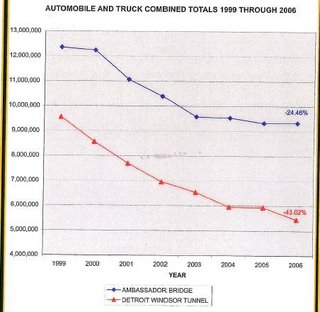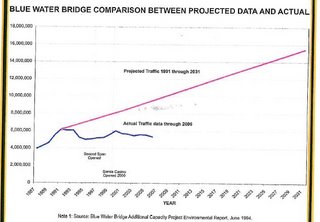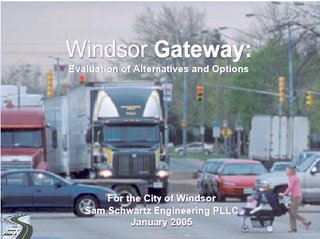Here is the complete transcript of the speech given by the Bridge Co. President to the Senate hearing on Bill C-3. Two of the Senators commented that Dan Stamper certainly spoke "candidly" and with "candour."
The most interesting part of the Senators' comments was that they thought the Bill was a "slam dunk" when they first read it. Now they understood a lot more about the issue of the Ambassador Bridge and the importance of the whole discussion on other projects that the Government wants to enter into. It is not going to be "fast-tracked" as the Government expected.
As well, certain graphs were shown by the Bridge Co. dealing with traffic projections that showed huge gaps between consultant projected and actual numbers.
A good part of Matthew Moroun's answers to questions were related to the economics of the P3 bridge and how Bill C-3 was needed to make that concept work. He tied it into what he called a "conflict theory" with Government.
I will try and get the full transcript of the hearings and make comments on it as soon as it is received!
Senate Committee Hearings
Ambassador Bridge Testimony offered November, 2006
Dan Stamper, President
Thank you for this opportunity to speak today on the proposed Bill C-3. With me are Matthew Moroun, one of our principals and Vice Chair of our company, and Thomas “Skip” McMahon, Executive Director of External Affairs.
First, let me say, we are disappointed with the intent and the spirit of Bill C-3 as it relates to our Company. There are 24 bridges, 22 publicly owned, one which is in the process of being sold and one private bridge, the Ambassador Bridge.
Our effort today is to clarify and offer meaningful facts and direction for improving and strengthening the relationship between Canada and the Ambassador Bridge.
We believed the governance of the Ambassador Bridge by Canada was resolved after more than a decade of litigation between the parties with an agreement reached in 1992. Having gone above and beyond the terms of our 1992 agreement, we are troubled and question the true intent of Bill C-3. Recent comments by the Ministers of Transport and Finance regarding Public/Private Partnerships make clear that Bill C-3, in combination with the work of the Detroit River International Crossing Project (DRIC), is an effort by bureaucrats to ensure that a Public/Private Border crossing is to be constructed, and to be made profitable, at our expense and that of the taxpayers of Canada.
I want to show you quickly 3 graphs. The first graph shows projected and actual volumes at the Blue Water Bridge, one of our main competitors for truck traffic. Please note the projected volumes that formed the basis of building a new twinned bridge there and new highway infrastructure on both sides of the border at a cost of billions of dollars to taxpayers. Also note the growing gap between actual and projected volumes. Actual volume has remained relatively stable despite the opening of a Casino in Sarnia. A private investor would be infuriated by this disparity between projected and actual traffic.
The second graph shows the actual traffic volumes at the Windsor border crossings since 1999. I am disappointed that the Mayor of Windsor would not answer your questions himself about the Tunnel’s decrease in traffic of over 40%.
Third and finally, I want to show you what the DRIC consultants project as volumes at the Ambassador Bridge compared with the actual and our projections. I should tell you that the DRIC consultants have already reduced their overly optimistic numbers downward several times. Note especially the huge gap developing over time between the DRIC projections and ours. Where is the justification for expending billions of dollars for another crossing?
Our Company is not engaged in some academic exercise in number crunching at our crossing. We have a responsibility and obligation to ensure that our crossing works to meet the needs of our customers and the region we serve. We are the ones who built this business to become the #1 border crossing in North America. We understand the border better than anyone.
The key elements of Bill C-3 are designed to give the bureaucrats the opportunity to take business away from our border crossing and send it to a government sponsored new bridge. In our opinion the creation of a marshalling yard and a new bridge with Bill C-3 will severely affect the financial condition or bankrupt the existing crossings in Southwest Ontario. Accordingly, it should not come as a surprise to anyone when we say that we will protect our business.
Let me talk about the DRIC process for a minute.
The facts are as follows:
A. We settled outstanding litigation with Canada and invested tens of millions of dollars in improving government facilities in 1992.
B. The Canadian Transit Company publicly began its effort to enhance its facilities in 1993 and has continued to acquire the necessary property and engage consultants and engineers to prepare all necessary documents and approvals to allow the construction of additional lanes over the water.
C. The ideal for DRIC was hatched in 2001 and has been rushed in an effort to catch up with and replace the Ambassador Bridge’s commitment for additional lanes.
D. The same bureaucrats in charge of the DRIC process are the people responsible for approvals of the Ambassador Bridge project. This creates a group of bureaucrats as a competitor of the Ambassador Bridge, at the government owned Sarnia / Port Huron bridge, and creates a direct conflict since they are judge, jury and executioner when it comes to the Ambassador Bridge projects.
E. Let me point out that it was the DRIC team, not us, that said “However, the Canadian evaluation notes a second span of the Ambassador Bridge would be an expansion of the existing crossing, not a new crossing of the river with new connections to the freeway systems in Ontario and Michigan.” DRIC has acknowledged that we were never bound by the DRIC process and are free to pursue our own crossing.
Are we overstating our position? I do not think so but let me pose this fact situation to you so that you will understand our point of view.
Recently, the DRIC issued a Request for Quotation. Its purpose was to allow the creation of a truck marshalling yard which would allow bureaucrats to redirect traffic to the border crossing of their choice. This initiative is necessary for the DRIC and Bill C-3 to accomplish their goals of supporting a new government sponsored bridge by redistributing traffic and tolls from existing border crossings. DRIC, Bill C-3, the marshalling yard and the expenditure of billions of dollars are not needed if the government would support the current border crossings and operators.
Our position is not difficult to understand. We are willing to compete and have been very successful in doing so. We have strong objection to bureaucratic control of a border-crossing market-place where customers may be driven away by uneconomic tolls and where our business is taken away from us by administrative action. We wish to carry on business the way we have done so for almost 80 years, in a successful alliance with the Government of Canada.
As an example of safety and security, immediately after 9/11 the Ambassador Bridge engaged, managed and are paying for 24 hour a day armed security at the Ambassador Bridge. Most of the latest security technology innovations are put into service first at the Ambassador Bridge. There is no reason why those sections of Bill C-3 could not be implemented quickly for the benefit of all and we suggest that this be done. After all, that should be the real driving motivation behind the statute.
Let me speak briefly about the ownership side of Bill C-3 that causes us the great concern.
The Government of Canada unilaterally is attempting to wipe away the strong, long-term relationship we have had with the governments of Canada and the United States with the stroke of a pen. Moreover, the Bill as drafted seems to allow the Government to act retroactively as well. (Section 57) The historic combination of U.S. and Canadian legislation that have been the controlling statutes for the operation of the Ambassador Bridge must not be unilaterally altered by Canada.
Let me now deal with some of the more onerous terms of the Bill that impact our business.
What business person would not object to legislation that allows a “public” competitor “unfettered discretion” to decide how it can compete and on what terms. The Government on the one hand competes against us for border traffic at Sarnia and possibly in Windsor and on the other hand sits as judge and jury as to the enhancement of our business (or worse: an executioner) in Windsor through the DRIC process and now the Environmental Process for our Enhancement Project.
As you are aware, there are numerous pieces of legislation governing the Ambassador Bridge not only in Canada but in the U.S. as well. This legislation in both countries has been created and together they govern the Ambassador Bridge as an international border crossing.
Any unilateral change may disrupt the meaning and application of these international agreements. If changes are needed, we are ready to work closely with the Government to develop meaningful legislation that continues to protect the public and creates an environment that not only allows for but motivates the border crossing owner / operators, whether public or private, to invest in and manage safe, secure and efficient border crossings for the good of Canada and the United States. We are NOT a new company starting out but a legitimate border operator who has done its best for the good of this Country and its American neighbor for over 75 years.
I do regret having to state that notwithstanding many attempts by us to meet with the Minister, he has refused to meet with us. May I respectfully ask that this Committee request that the Minister get together with us. Frankly, I would have hoped that many of the issues I am discussing today could have been resolved already in a more expeditious manner had there been such senior level conversations.
Mr. Brian Hicks (Director, Bridge Policy and Programs, Department of Transport) stated
“the Americans have a presidential permit process, and the U.S. federal government steps in when a bridge is going to be constructed or if there are major alterations on the bridge.”
A Presidential Permit process in the U.S. specifically states that this Act shall not be construed to adversely affect the rights of those operating bridges previously authorized by Congress to repair, replace or enlarge existing bridges.
In our view, the actions of Canada under this Bill are out of step with those of the United States. That should be troubling to you because the Transport Canada has said that one of its objectives is to make the process in Canada similar to that of the process in the Unites States.
The Ambassador Bridge twin span was the highest performing alternative and least expensive span to construct on the US side according to the DRIC Study. The Ambassador Bridge already owns the necessary property for our second span, preventing costly condemnation in another neighbourhood. The Ambassador Bridge Gateway Project under both Michigan Governors Engler and Granholm anticipated a twin span at this location for more than a decade. The Ambassador Bridge as an existing crossing already has clearance from the US Dept. of State, whereas any other DRIC crossing would require a new Presidential Permit.
With respect to our Enhancement Project, we have already spent about a half a billion dollars for our project. This is our money, not that of any Government, used for engineering and design work and in purchasing the properties necessary for the construction for our Enhancement Project. We anticipate spending at least another half billion dollars of our money to build the Twinned Span. If that does not demonstrate positively our commitment to the region and to the efficient flow of people and goods then nothing will.
The enhancement would include a new six lane cable stayed bridge located in the same corridor near the existing Ambassador Bridge, consistent with the approved and ongoing Gateway Project. This bridge would tie directly into the existing plazas in both Canada and the United States without modification to their currently approved and permitted configuration. Once the new structure is completed, the existing Ambassador Bridge will be taken out of service for some period of time to effect repairs that are deemed necessary. Once any necessary repairs are completed, the existing structure will be used to provide redundancy and backup support when necessary to ensure the free flow of traffic between Windsor and Detroit at all times. In other words, we will NOT be destroying the communities of Sandwich in Ontario or Delray in Michigan or both as the DRIC plan would do. Moreover, our actions are similar to the twinning of the Blue Water bridge in Sarnia.
We would like to invite any and all members of the Senate to visit the Ambassador Bridge for a tour, either as a group or as individuals. We would be pleased to host such a tour of the entire facility so they are able to see first hand that it is a total international piece of infrastructure, not just two halves being operated separately.
In conclusion,
We respectively ask for the following amendments:
That Bill C-3, at Clause 2, be amended
(a) by replacing line 18 with the following:
“international bridge or tunnel” means a publicly owned bridge”……
That Bill C-3, at Clause 4, identifies the schedule that forms part of Bill C-3, and that said schedule should be amended by
(a) deleting item 34, “An Act to incorporate The Canadian Transit Company, S.C. 1921, c.57.”
That Bill C-3, at Clause 57, be amended
(a) by replacing line 23 with the following:
“of the Government of Canada, specifically this Act shall not be construed to adversely affect the rights of those operating bridges previously authorized by Parliament, to repair, replace or enlarge existing bridges. ”
We recognize that there are necessary approvals to complete this project and they are currently underway beginning with the Environmental Assessment.
We fully acknowledge that we are not legislative drafters however we hope that your legislative drafters could assist by reviewing and properly revising the amendments required to fulfill this intent.
Recognizing that we are one of two privately owned commercial international bridges, we face similar but also many different challenges from the other 22 publicly owned International Bridges. Bill C-3 as it is currently drafted in our opinion does not reflect this.
My ultimate message is that the Ambassador Bridge Company wants to work co-operatively with the Government and those others involved for the good of both citizens and the economy. Do not allow C-3 to unilaterally destroy the collective historic legislation between the United States and Canada that has produced the most efficient border crossing in North America.
We are pleased to entertain any questions you may have.













